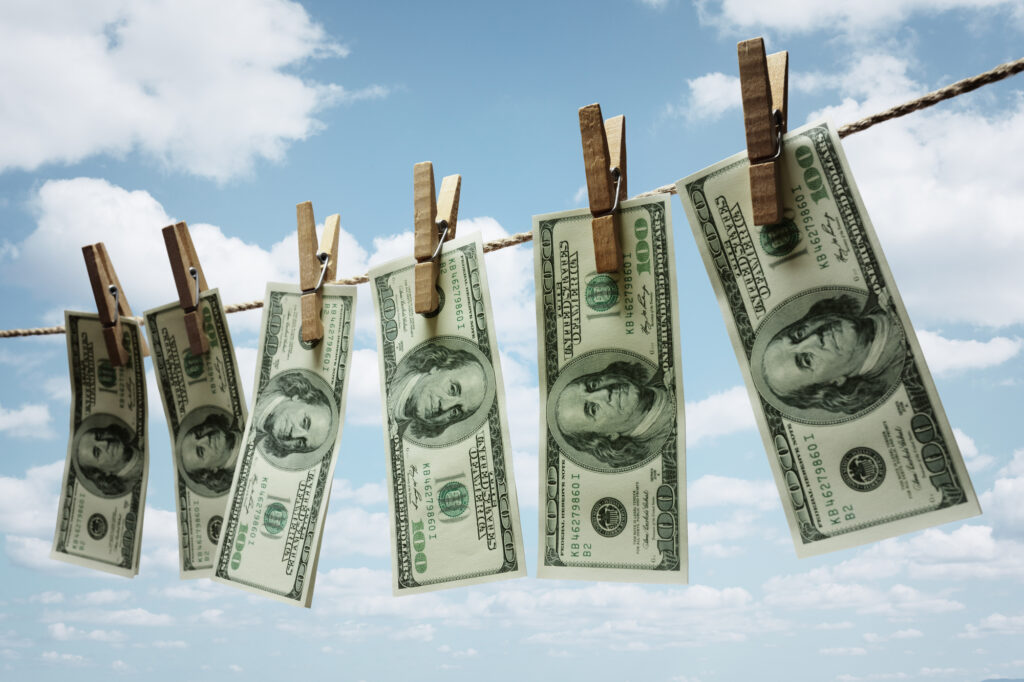
Money laundering is a complex and clandestine process that has far-reaching implications for economies and societies around the world. It’s a financial crime that allows illicit funds to enter the legitimate financial system, making them appear clean and untraceable. In this article, we will explore what money laundering is, its various stages or levels, the motivations behind it, and how criminals engage in this illicit activity.
Contents [hide]
What is Money Laundering?
Money laundering is the process of making illegally obtained money, often referred to as “dirty money,” appear legitimate or “clean” by funneling it through a series of financial transactions or commercial activities. This nefarious practice is used by criminals to obscure the source of their ill-gotten gains, making it difficult for law enforcement agencies to track and seize these assets.
Why is it called money laundering?
The term “money laundering” has historical roots that are tied to the process itself. The term “money laundering” metaphorically refers to the process of making illegally obtained or “dirty” money appear clean or legitimate. This metaphor draws an analogy to the process of laundering dirty clothes, where the goal is to make them appear clean and fresh.
In the context of financial crime, laundering involves taking money that has been acquired through illegal means, such as drug trafficking or other criminal activities, and then using a series of financial transactions or other methods to make it appear as if the money was obtained legally. This process effectively “cleans” the money of its illicit origins, allowing criminals to enjoy the proceeds without arousing suspicion.
The term “money laundering” has been used since at least the early 20th century to describe this process, and it has become a common term in law enforcement, finance, and legal circles to refer to the act of disguising the source of illegally obtained funds.
3 Stages of Money Laundering
Money laundering typically involves several stages or levels, each designed to distance the tainted funds from their criminal origins:
1. Placement
This is the first stage where the illicit funds are introduced into the financial system. Criminals often break down large amounts of dirty money into smaller sums to avoid suspicion. Common methods include depositing cash in banks, using it to buy assets like real estate or luxury goods, or even smuggling it across borders.
2. Layering
In this stage, the aim is to create a complex web of financial transactions to obscure the origin of the funds. Criminals move the money through a series of accounts, both domestically and internationally, making it difficult to trace. They might also engage in fictitious invoicing, stock trading, or shell companies to further complicate the paper trail.
3. Integration
At the final stage, the “cleaned” funds are reintroduced into the legitimate economy. Criminals often invest the money in legal businesses, such as restaurants, casinos, or real estate, where it can be easily mingled with legitimate earnings. This integration phase solidifies the funds’ appearance as clean, allowing criminals to enjoy their ill-gotten gains without arousing suspicion.
Motivations Behind Money Laundering
People engage in laundering for a variety of reasons, including:
1. Concealment
Criminals want to conceal the illegal source of their wealth to avoid prosecution and asset forfeiture.
2. Access to Funds
Money laundering enables criminals to access their illicit gains for personal use or reinvestment.
3. Legitimacy
It allows criminals to legitimize their wealth and gain acceptance in society, making it easier to engage in legal business activities.
4. Tax Evasion
Money launderers may use the process to evade taxes on their ill-gotten gains.
5. Funding Criminal Activities
Money laundering is often used to finance other criminal activities, such as drug trafficking, terrorism, or corruption.
How is Money Laundering Done?
Money laundering takes various forms, and the prevalence of each method can vary depending on the region and the specific criminal activities involved. Some of the most common forms include:
1. Shell Companies
Criminals set up fake companies with no legitimate business activity. They use these entities to funnel dirty money, making it appear as revenue, loans, or investments.
2. Smurfing
This involves breaking down large sums of dirty money into smaller, less suspicious transactions, which are then deposited into multiple bank accounts.
3. Cryptocurrencies
Criminals may use cryptocurrencies like Bitcoin to obscure the source and destination of funds.
4. Real Estate
Buying luxury real estate with dirty money is a common method, as it can be difficult to trace ownership.
5. Offshore Accounts
Opening bank accounts in jurisdictions with strict bank secrecy laws helps conceal the true owner of the funds.
6. Front Businesses
Criminals may invest in legitimate businesses and use them as a cover to mix illicit funds with legal income. Criminals may use cash-intensive businesses like casinos, restaurants, bars, strip clubs, or retail stores to mix dirty money with legitimate earnings.
7. Bank Deposits
Criminals deposit large sums of cash into banks, often in amounts below the threshold for mandatory reporting. They may then gradually withdraw the money or transfer it to other accounts.
The prevalence of these methods can change over time as regulations and law enforcement efforts evolve. Money launderers often adapt their techniques to exploit vulnerabilities in the financial system, making it a constant challenge for authorities to combat this illicit activity effectively.
Money Laundering FAQs
Get answers to your most pressing questions about money laundering in our frequently asked question section.
What is the Netflix show about money laundering?
The Netflix show about money laundering is titled “Ozark” starring Jason Bateman (one of my favorite actors). It’s a crime drama series that follows the story of a financial planner who relocates his family to the Ozarks to launder money for a Mexican drug cartel.
How much money is considered laundering?
The threshold for what amount of money is considered money laundering can vary depending on the jurisdiction and its laws. There is no universally fixed amount that universally qualifies as money laundering. In many countries, money laundering laws focus more on the act itself rather than a specific monetary threshold.
However, large financial transactions or patterns of financial activity that appear suspicious to financial institutions may trigger reporting requirements. For instance, in the United States, banks are required to report cash transactions of $10,000 or more to the Financial Crimes Enforcement Network (FinCEN) as a part of the Bank Secrecy Act. Suspicious transactions or patterns that don’t meet this threshold might also be reported.
It’s important to note that money laundering laws aim to detect and prevent illegal financial activities, so authorities pay attention not only to the amount of money involved but also to the intent and actions of those involved in financial transactions.
What type of crime is money laundering?
Laundering money is a financial crime. The funds involved in money laundering typically originate from various criminal activities such as drug trafficking, bribery, tax evasion, corruption, fraud, organized crime, and other unlawful activities. This serves to obscure the connection between these criminal activities and the assets derived from them, making it difficult for law enforcement agencies to trace and confiscate the proceeds.
To combat money laundering, many countries have established specific laws, regulations, and enforcement agencies dedicated to preventing, detecting, and prosecuting this financial crime. These legal frameworks are often referred to as Anti-Money Laundering (AML) laws and regulations, and they impose obligations on financial institutions, businesses, and individuals to report suspicious financial activities and take measures to prevent money laundering. Violations of these AML laws can result in criminal charges and penalties.
What is the minimum sentence for laundering money?
The minimum sentence for laundering money varies widely depending on the jurisdiction, the specific laws in place, and the severity of the offense. In the United States, for example, the minimum sentence can range from several years to even longer, depending on factors like the amount of money involved and whether it’s linked to other criminal activities. In other countries, the minimum sentence may differ significantly. It’s essential to consult the specific laws and regulations in your jurisdiction to determine the minimum sentence for money laundering in that particular location.
Money Laundering Conclusion
Money laundering is a complex and pervasive global problem with serious economic, social, and security implications. Understanding its various stages, motivations, and methods is crucial for governments, financial institutions, and individuals to combat this illicit practice. Authorities worldwide continue to work together to develop laws, regulations, and technological tools to detect and prevent money laundering, aiming to maintain the integrity of the global financial system and protect society from the harmful effects of financial crime.
Featured Image Credit: Deposit Photos




